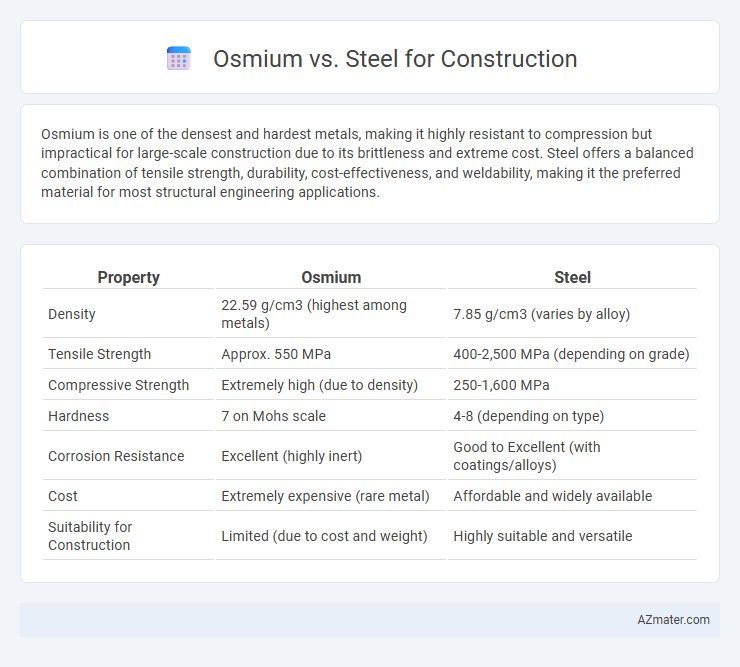Osmium is one of the densest and hardest metals, making it highly resistant to compression but impractical for large-scale construction due to its brittleness and extreme cost. Steel offers a balanced combination of tensile strength, durability, cost-effectiveness, and weldability, making it the preferred material for most structural engineering applications.
Table of Comparison
| Property | Osmium | Steel |
|---|---|---|
| Density | 22.59 g/cm3 (highest among metals) | 7.85 g/cm3 (varies by alloy) |
| Tensile Strength | Approx. 550 MPa | 400-2,500 MPa (depending on grade) |
| Compressive Strength | Extremely high (due to density) | 250-1,600 MPa |
| Hardness | 7 on Mohs scale | 4-8 (depending on type) |
| Corrosion Resistance | Excellent (highly inert) | Good to Excellent (with coatings/alloys) |
| Cost | Extremely expensive (rare metal) | Affordable and widely available |
| Suitability for Construction | Limited (due to cost and weight) | Highly suitable and versatile |
Introduction to Osmium and Steel in Construction
Osmium is a rare, dense metal primarily used in specialized applications due to its exceptional hardness and corrosion resistance, but its high cost and brittleness limit its use in general construction. Steel, an alloy of iron and carbon, dominates the construction industry because of its favorable strength-to-weight ratio, versatility, and cost-effectiveness. Comparing osmium and steel highlights steel's practicality for large-scale structural projects, while osmium remains valuable for niche, high-performance uses requiring durability and density.
Material Properties: Osmium vs Steel
Osmium exhibits exceptional density and hardness, making it one of the densest naturally occurring elements, with a density of approximately 22.59 g/cm3, while steel typically has a density around 7.85 g/cm3. Steel boasts superior tensile strength and flexibility, critical for structural applications, whereas osmium's brittleness limits its use in construction despite its hardness. The corrosion resistance of osmium is notably higher, but steel's versatility, cost-effectiveness, and weldability make it the preferred choice for building frameworks and infrastructure.
Strength and Durability Comparison
Osmium exhibits exceptional density and hardness, making it one of the strongest natural metals, yet its brittleness limits practical construction use compared to steel. Steel offers a superior balance of tensile strength, flexibility, and durability under varying environmental stresses, making it the preferred choice for structural applications. The corrosion resistance of steel alloys also enhances longevity in construction, whereas osmium's rarity and cost impede its feasibility despite its strength advantages.
Corrosion Resistance and Longevity
Osmium exhibits exceptional corrosion resistance due to its dense atomic structure and inherent chemical inertness, making it highly durable in harsh environments compared to steel. Steel, although widely used in construction, is prone to rust and corrosion unless coated or alloyed with elements like chromium to form stainless steel. The longevity of osmium far surpasses that of conventional steel, as it maintains structural integrity without degradation over extended periods, ideal for applications requiring minimal maintenance and maximum durability.
Density and Weight Considerations
Osmium has an extremely high density of approximately 22.59 g/cm3, making it one of the densest naturally occurring elements, whereas steel typically ranges between 7.75 and 8.05 g/cm3. This significant difference in density means osmium components would be substantially heavier than steel parts of the same volume, impacting structural load and transportation costs. Steel's lower weight-to-strength ratio makes it more practical for construction applications where balance between durability and manageable weight is essential.
Cost and Economic Feasibility
Osmium, known for its extreme density and hardness, presents prohibitively high costs and limited availability, making it economically unfeasible for large-scale construction projects. Steel, by contrast, offers a cost-effective balance of strength, durability, and widespread availability, driving its dominance in the construction industry. The relative affordability and ease of fabrication of steel alloys ensure optimal economic feasibility for structural applications compared to rare metals like osmium.
Workability and Fabrication Techniques
Osmium's extreme density and hardness make it exceptionally difficult to machine and shape, limiting its practicality for typical construction workability compared to steel. Steel's well-established fabrication techniques, such as welding, cutting, and forming, allow for versatile and efficient construction processes. Workability challenges with osmium include brittleness and high melting point, which hinder standard fabrication, while steel's ductility and thermal properties support widespread use in structural applications.
Environmental Impact and Sustainability
Osmium, despite its exceptional density and strength, is rarely used in construction due to its scarcity and extreme environmental impact from mining processes, making it less sustainable than steel. Steel remains the preferred material in construction for its recyclability, lower carbon footprint, and established infrastructure for sustainable production methods such as electric arc furnace recycling. Incorporating recycled steel significantly reduces energy consumption and greenhouse gas emissions compared to producing new osmium or virgin steel, underscoring steel's superiority in environmental sustainability for construction projects.
Common Applications in Modern Construction
Osmium, known for its extreme density and hardness, is rarely used in construction due to its brittleness and high cost, limiting its applications to specialized components like electrical contacts and scientific instruments. Steel remains the dominant material in modern construction, prized for its strength, flexibility, and cost-effectiveness, making it ideal for structural frameworks, reinforcement bars, and bridges. Common applications of steel in construction include beams, columns, and rebar, supporting both residential and large-scale infrastructure projects worldwide.
Conclusion: Choosing the Right Material
Osmium offers exceptional hardness and density, making it suitable for specialized applications requiring extreme durability, while steel provides a balanced combination of strength, flexibility, and cost-efficiency essential for most construction projects. Steel's widespread availability, ease of fabrication, and proven performance under various environmental conditions make it the preferred choice for structural frameworks and large-scale buildings. Selecting the right material depends on project-specific requirements, with steel generally favored for its versatility and economical advantages over osmium's niche use cases.

Infographic: Osmium vs Steel for Construction
 azmater.com
azmater.com